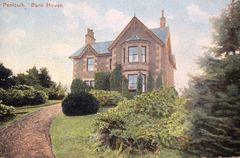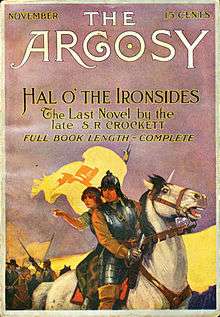S. R. Crockett
| S. R. Crockett | |
|---|---|
 Samuel Rutherford Crockett, by Elliott & Fry | |
| Born |
24 September 1859 Duchrae, Balmaghie, Kirkcudbrightshire |
| Died |
16 April 1914 (aged 54) France |
| Resting place | Balmaghie |
| Occupation | Minister |
| Ethnicity | Scottish |
| Period | 1890-1914 |
| Genre | Novel |
Samuel Rutherford Crockett (24 September 1859 – 16 April 1914), who published under the name "S. R. Crockett", was a Scottish novelist.
Life
He was born at Duchrae, Balmaghie, Kirkcudbrightshire, on 24 September 1859, the illegitimate son of dairymaid Annie Crocket. He was raised on his grandfather's Galloway farm, won a bursary to Edinburgh University in 1876,[1] and graduated from there during 1879.[2]
After some years of travel, he became in 1886 minister of Penicuik. During that year he produced his first publication, Dulce Cor (Latin: Sweet Heart), a collection of verse under the pseudonym Ford Brereton. He eventually abandoned the Free Church ministry for full-time novel-writing in 1895.[2]

The success of J. M. Barrie and the Kailyard school of sentimental, homey writing had already created a demand for stories in Lowland Scots,[3] when Crockett published his successful story of The Stickit Minister in 1893.[2] It was followed by a rapidly produced series of popular novels frequently featuring the history of Scotland or his native Galloway. Crockett made considerable sums of money from his writing and was a friend and correspondent of R. L. Stevenson, but his later work has been criticised as being over-prolific and feebly sentimental.[4]
Crockett's connection with Kailyard is now beginning to be acknowledged as nebulous at best, as evidenced by a re-appraisal of the whole Kailyard concept by writers such as Andrew Nash.[5]
In 1900, Crockett wrote a booklet published by the London camera manufacturer, Newman & Guardia, comparing cameras favourably to pen and pencil and explaining how he encountered the N and G advertisement.[6]
Crockett was well travelled in Europe and beyond, spending time in most European countries and he wrote several novels of European history including The Red Axe (1898), A Tatter of Scarlet (1913), and the non fiction The Adventurer in Spain (1903) which holds its own against Robert Louis Stevenson's travel writing.
He died in France on 16 April 1914. The subsequent outbreak of the First World War meant a delay in his remains being buried in his home kirkyard at Balmaghie. A memorial to him was erected in Laurieston by public subscription in 1932.
Legacy and influence
- A monument to Crockett can be seen at Laurieston, near Castle Douglas, Kirkcudbrightshire. His papers are held by Edinburgh University.[7] A biography of S.R. Crockett was published in 1991, by Dr. Islay Donaldson.
In 2014 The Galloway Raiders was set up as a literary society and online presence to explore his life and work and restore his credibility as one of Scotland's great writers. The Galloway Raiders also holds two archives of Crockett material; that of his biographer Dr Islay Donaldson, 'The Donaldson Archive' and Crockett scholar Richard D.Jackston 'The Jackson archive' [8]
- J. R. R. Tolkien credits him as an influence on his wolf-fight scenes: "the episode of the 'wargs' (I believe) is in part derived from a scene in S. R. Crockett's The Black Douglas, probably his best romance and anyway one that deeply impressed me in school-days".[9]
Works


A full list of Crockett's published works (67 volumes) is published online by The Galloway Raiders A substantial number of his works have been republished since the 100th anniversary of his death and are available as print or digital versions. The list below is not comprehensive:
- The Sticket Minister, London : T.F. Unwin, 1893; New York : Caldwell, 1893
- The Raiders : being some passages in the life of John Faa, Lord and Earl of Little Egypt, London : T.F. Unwin, 1894; Toronto : W.Briggs, 1894
- The Lilac Sun-bonnet, D. Appleton and company, 1895
- Mad Sir Uchtred, London : T.F. Unwin, 1894
- The Men of the Moss Hags, London : Isbister & Co., 1895
- Sweetheart Travellers London : Wells Gardner, Darton & Co., 1895; New York : F.A. Stokes, c.1895
- Cleg Kelly, New York : D. Appleton & Co., 1896
- The Gray Man, New York, Harper & Brothers, 1896; The Grey Man, Leipzig : Bernhard Tauchnitz, 1896
- The Surprising Adventures of Sir Toady Lion with those of General Napoleon Smith, London : Garden, Dartner & Co., 1897
- Lochinvar, Copyright 1897, Published (1898) by Harper and Brothers
- The Standard Bearer, London : Methuen, 1898; New York, D. Appleton & Co, 1898
- The Red Axe, London : Smith, Elder & Co., 1898; New York : Harper & Bros, 1898
- The Black Douglas Toronto : G.N. Morang, 1899[10][11][12] published by Doubleday & McClure Co.
- Kit Kennedy, London : T.F. Unwin, 1899; Toronto : W. Briggs, 1899
- Joan of the Sword Hand, Toronto : Copp, Clark, 1900
- Little Anna Mark, London : Smith, Elder & Co., 1900
- Cinderella: a novel, London : James Clarke & Co., 1901; Toronto : Copp, Clarke, 1901
- The silver skull, London : Smith, Elder, 1901
- The firebrand, London : Macmillan, 1901
- Flower o' the Corn, London : James Clarke, 1902
- Red Cap Tales, Adam and Charles Black, 1904
- Raiderland, Dodd, Mead and Company, 1904
- The Loves of Miss Anne, Macmillan, 1904
- Maid Margaret, London : Hodder & Stoughton, 1905
- The Adventurer in Spain Ibister and Co., Ltd., 1903 (non-fiction)
- The white plumes of Navarre, Religious Tract Society, 1906
- Red Cap Tales, stolen from the treasure chest of the Wizard of the North, which theft is humbly acknowledge by S.R. Crockett, New York : Macmillan, 1906
- Little Esson, London : London, Ward, Lock & Co., 1907
- Red Cap Adventures : being the second series of Red Cap tales stolen from the treasure chest of the Wizard of the North, which theft is humbly acknowledge by S.R. Crockett, New York : Macmillan, 1908
- Silver Sand, London & New York : Hodder & Stoughton, 1914
- The Azure Hand, London : Hodder & Stoughton, 1917 (posthumous)
Notes
The Raiders concerns the historical Gypsy leader John Faa, who much later becomes a character in His Dark Materials.
The Black Douglas features Gilles de Retz, the associate of Joan of Arc and the reputed origin of Bluebeard.[13]
See also
References
- ↑ D. Daiches ed., "The Penguin Companion to Literature: 1" (1971) p. 127
- 1 2 3 Chisholm 1911.
- ↑ I. Ousby ed., The Cambridge Guide to Literature in English (1995) p. 503
- ↑ D. Daiches ed., The Penguin Companion to Literature: 1 (1971) p. 127
- ↑ Kailyard and Scottish Literature,2007
- ↑ British Journal of Photography, 20 July 1900, p. 450.
- ↑ "The papers of Samuel Rutherford Crockett". Edinburgh University. Retrieved 4 January 2012.
- ↑
- ↑ Quoted in J. D. Rateliff, Mr Baggins (2007) p. 216
- ↑ Project Gutenberg
- ↑ Google Books
- ↑ Goodreads
- ↑ J. D. Rateliff, Mr Baggins (2007) p. 216 and p. 224
- Attribution
 Chisholm, Hugh, ed. (1911). "Crockett, Samuel Rutherford". Encyclopædia Britannica (11th ed.). Cambridge University Press.
Chisholm, Hugh, ed. (1911). "Crockett, Samuel Rutherford". Encyclopædia Britannica (11th ed.). Cambridge University Press.
Sources
- Bleiler, Everett (1948). The Checklist of Fantastic Literature. Chicago: Shasta Publishers. p. 88.
Further reading
M. M. Harper, Crockett and Grey Galloway (1907)
External links
| Wikimedia Commons has media related to Samuel Rutherford Crockett. |
- "Samuel Rutherford Crockett"], Ayton Publishing and Galloway Raiders
- Works by S. R. Crockett at Project Gutenberg
- Works by or about S. R. Crockett at Internet Archive
- Works by S. R. Crockett at LibriVox (public domain audiobooks)

- "Samuel Rutherford Crockett", Dumfries and Galloway